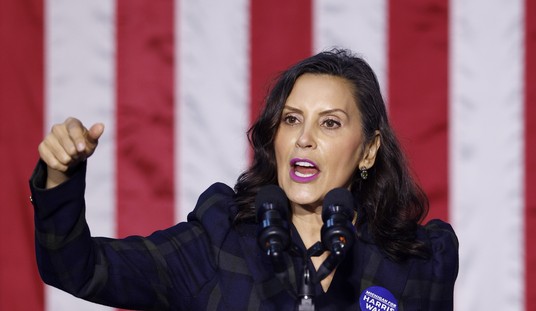Totally expected, and yet devastating nonetheless. Over the last four weeks, 17 million Americans have lost their jobs to the COVID-19 shutdown. The only consolation is that the pace slowed slightly from the previous week — and that this is, to some extent, a lagging indicator:
In the week ending April 4, the advance figure for seasonally adjusted initial claims was 6,606,000, a decrease of 261,000 from the previous week’s revised level. The previous week’s level was revised up by 219,000 from 6,648,000 to 6,867,000. The 4-week moving average was 4,265,500, an increase of 1,598,750 from the previous week’s revised average. The previous week’s average was revised up by 54,750 from 2,612,000 to 2,666,750.
The advance seasonally adjusted insured unemployment rate was 5.1 percent for the week ending March 28, an increase of 3.0 percentage points from the previous week’s unrevised rate. The advance number for seasonally adjusted insured unemployment during the week ending March 28 was 7,455,000, an increase of 4,396,000 from the previous week’s revised level. This marks the highest level of seasonally adjusted insured unemployment in the history of the seasonally adjusted series. The previous high was 6,635,000 in May of 2009. The previous week’s level was revised up 30,000 from 3,029,000 to 3,059,000. The 4-week moving average was 3,500,000, an increase of 1,439,000 from the previous week’s revised average. The previous week’s average was revised up by 7,500 from 2,053,500 to 2,061,000.
Bear in mind that some small number of the people who filed these claims over the last four weeks might have found other work. That won’t be a million of them, let alone 17 million of them, however, which means that the adjustment would be microscopic at best. With a workforce of 156 million Americans, it means that we have added 11 points to the unemployment rate in just a month.
Some of those could end up getting recalled to work at some point, if the CARES Act has the impact intended by lawmakers. That’s why this is in part a lagging indicator; the final day of this reporting period is April 4, the day after the Paycheck Protection Program first started accepting applications for the free-money loans to small- and medium-sized businesses. The few days’ delay in passing the CARES Act could have prevented last week’s jobless-claims report from providing us some real data on its effectiveness, although the money might not have flowed fast enough to make a difference. This week’s report, which will come out next Thursday, will provide a more significant marker on whether we have stemmed the layoff/furlough tide.
However, all sides in Washington largely agree that the funds for the PPP and the other bailouts in the CARES Act won’t be enough. The SBA has gotten dibs on roughly 20% of the appropriation in just the first four days, and they will run out of cash before Congress gets back to business:
The Paycheck Protection Program in the third economic rescue package gave the Small Business Administration $349 billion to distribute through private lenders to small businesses that keep paying their workers during the coronavirus shutdowns. Companies can get forgivable loans for up to eight weeks’ worth of payroll and other fixed debts, and if they use it mostly to pay staff, they won’t need to pay it back.
Lenders started taking applications Friday and the demand has been so overwhelming that the administration has asked Congress for another $251 billion. The SBA recorded 220,000 loans for $66 billion as of Tuesday.
The easiest action to take would be to simply appropriate more funds for the PPP. That’s what Republicans want to do, but Democrats want to fund a broader range of initiatives. They may come to loggerheads later today rather than an agreement in a potential replay of the CARES Act standoff:
Senate Majority Leader Mitch McConnell, R-Ky., has taken steps to try approving the additional money by unanimous consent during Thursday’s pro forma session, but Democrats have made a counter proposal. Unless the two sides can come to an agreement, the program’s funds might run out before Congress’s scheduled return on April 20.
Speaker Nancy Pelosi, D-Calif., said in an NPR interview Wednesday that Democrats don’t agree with the current $251 billion package being backed by the Senate and White House, and cast doubt on whether it could clear the House.
“The bill that they put forth will not get unanimous support in the House, it just won’t,” Pelosi said.
Pelosi outlined specific items Democrats want to see in their version. That included $250 billion more for local governments and hospitals, and specifying $60 billion of the already proposed money to go to businesses that are “underbanked” or “unbanked.”
That got Donald Trump irritated in his briefing last night:
The White House wanted the Senate to vote on the measure Thursday and the House to pass it by Friday, but as of late Wednesday it was unclear how Congress would proceed.
“We do not have time for the partisan games and we don’t want that, the obstruction or the totally unrelated agendas,” Trump said Wednesday.
To move on such a tight deadline, Congress would need unanimous consent, a dynamic that gives individual lawmakers extreme leverage to halt any bill.
Here we go again. The reason it would require unanimous consent is that Congress is in recess and won’t return until the 20th, the same day the funding will likely run out. Both Nancy Pelosi and Mitch McConnell had plenty of opportunity to change rules to allow for remote voting in this crisis, but both refused to do so. Congress needs to find a way to do its job in a pandemic, so either they need to reassemble long enough to change those rules or reassemble now to handle its responsibilities. Either way, they should be on the job, not on recess.
The Fed has decided not to wait for the Mitch & Nancy Show:
The Federal Reserve on Thursday released long-awaited details regarding its Main Street business lending program and several other initiatives it is undertaking to backstop the reeling U.S. economy.
Under provisions outlined for the first time, the loans would be geared toward businesses with up to 10,000 employees and $2.5 billion in revenues for 2019.
The Fed said the programs would total up to $2.3 trillion and include the Payroll Protection Program and other measures.
“Our country’s highest priority must be to address this public health crisis, providing care for the ill and limiting the further spread of the virus,” Fed Chair Jerome Powell said in a statement. “The Fed’s role is to provide as much relief and stability as we can during this period of constrained economic activity, and our actions today will help ensure that the eventual recovery is as vigorous as possible.”
Actually, that’s Congress’ job. And 17 million Americans might be wondering why they’re not doing it.
Update: Right on schedule, two Senate Democrats block an attempt to use unanimous consent to provide more PPP funding:
Democrats @BenCardinforMD and @ChrisVanHollen object to McConnell's call for Unanimous Consent approval of additional $250-billion in funding for the Paycheck Protection Program. Dems say addtl funding not yet needed and call proposal a political stunt by GOP. pic.twitter.com/Ld9BiOeKPC
— Mark Knoller (@markknoller) April 9, 2020
The only action coming from this rump Congress are stunts. Get everyone back to the Capitol where they belong in a national emergency, or pass rule changes that allow for remote debate and voting.








